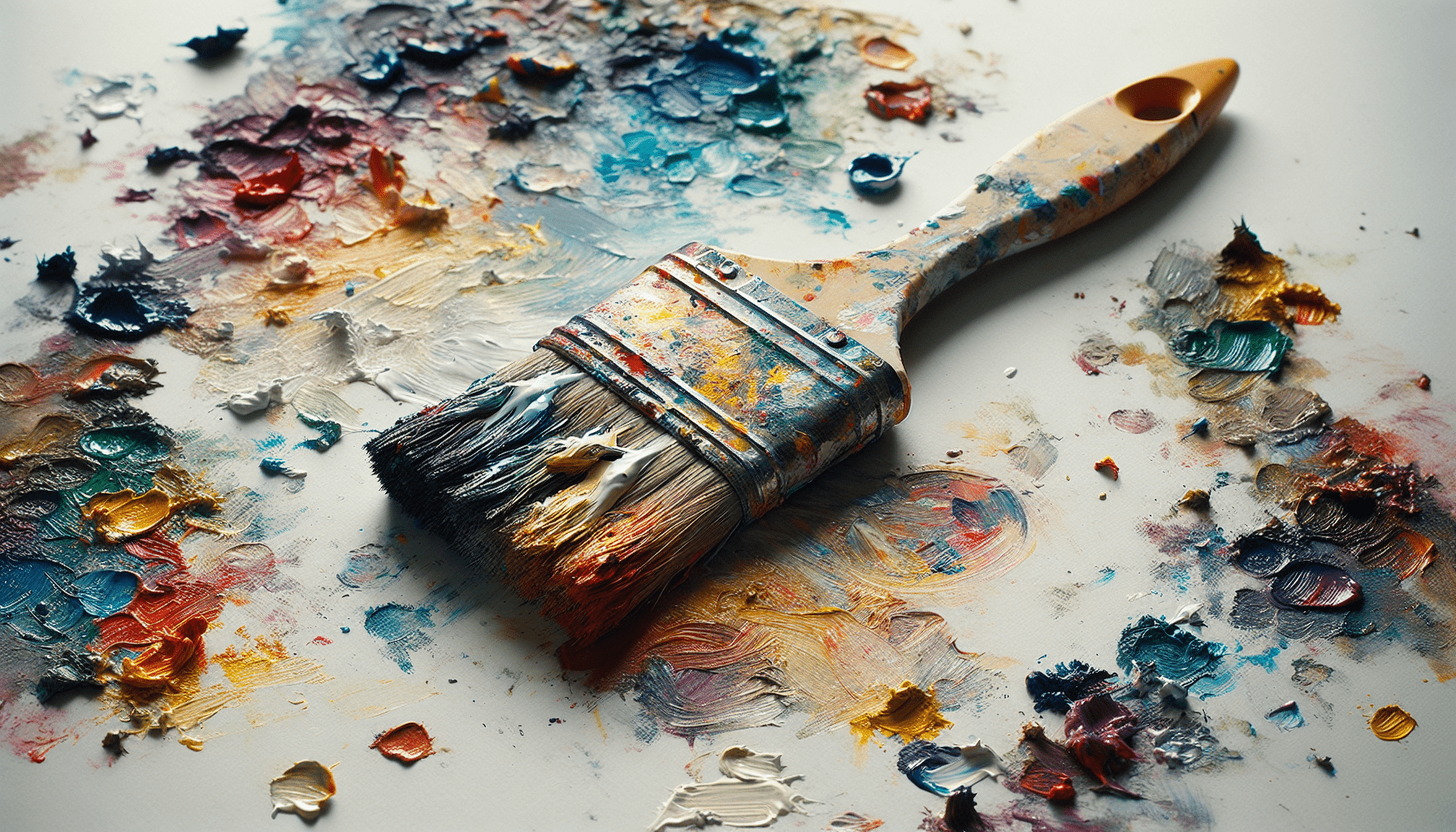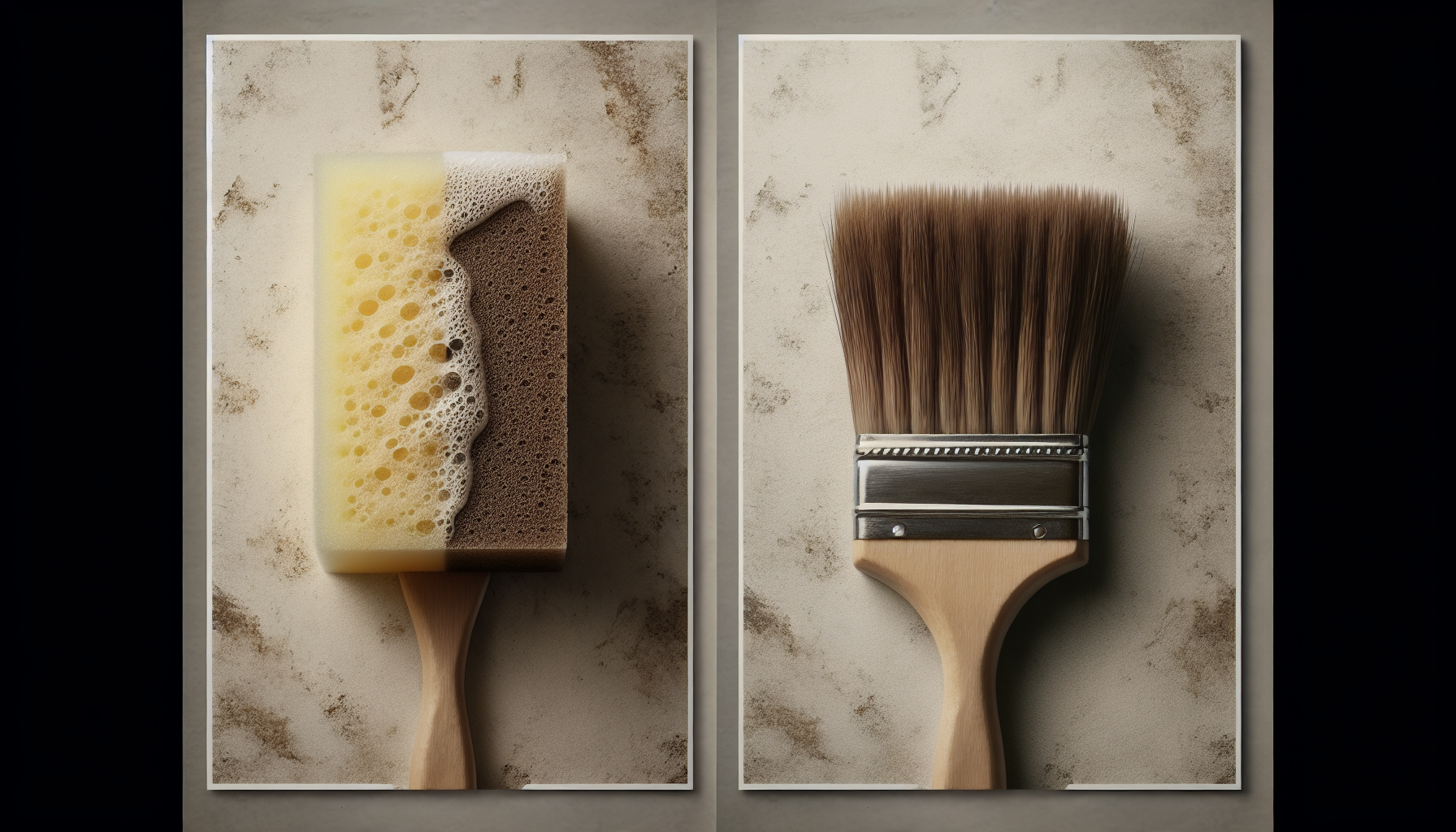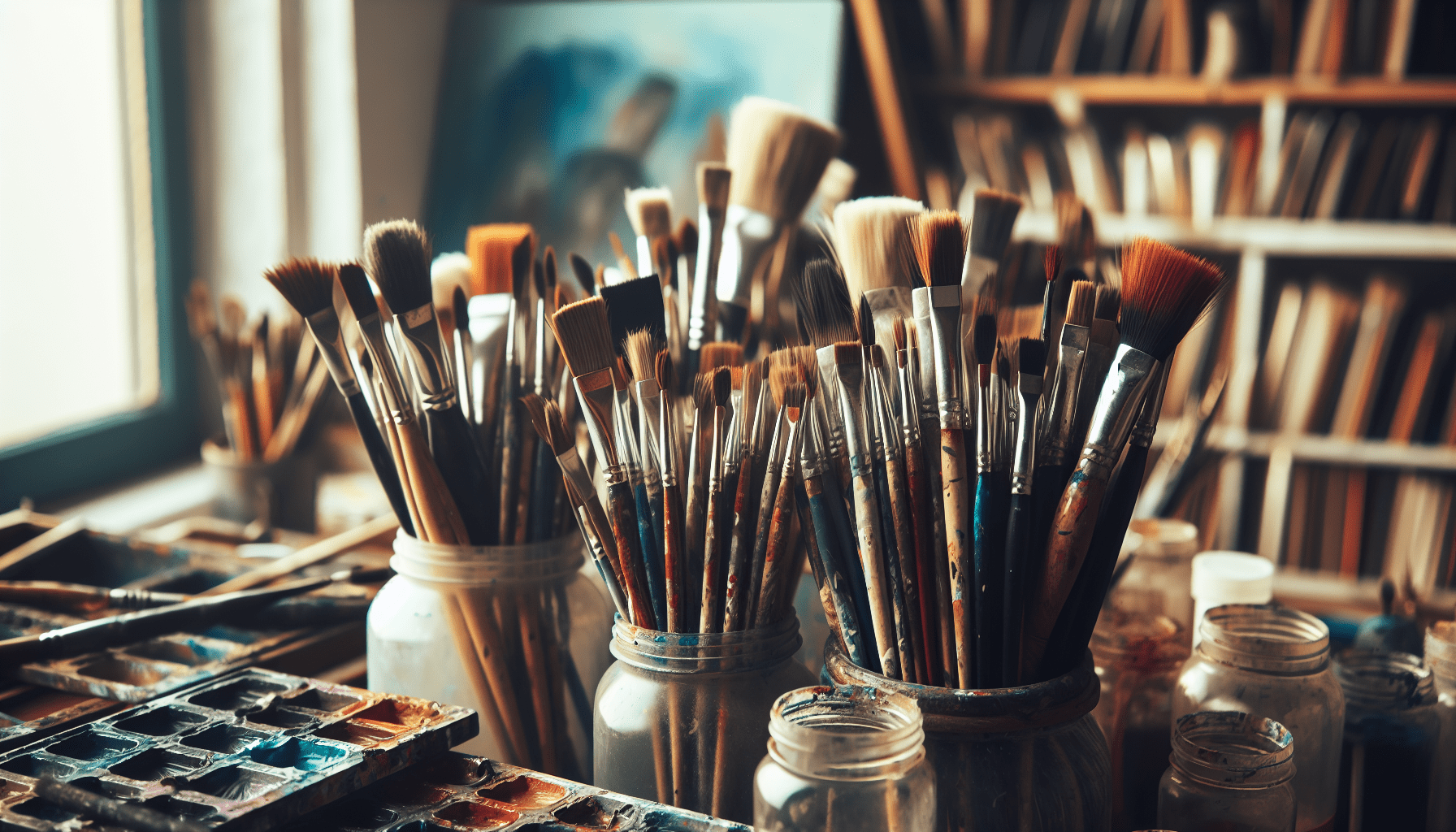Maintaining the pristine condition of your paint brushes is crucial for achieving flawless and professional-looking results in any artistic endeavor or home improvement project. However, the accumulation of dried paint on the bristles can compromise the quality and functionality of your brushes. In this article, we will explore effective techniques and methods to safely remove dried paint from paint brushes, allowing you to extend their lifespan and ensure optimal performance. Find out how you can salvage your valuable tools and restore them to their original glory.
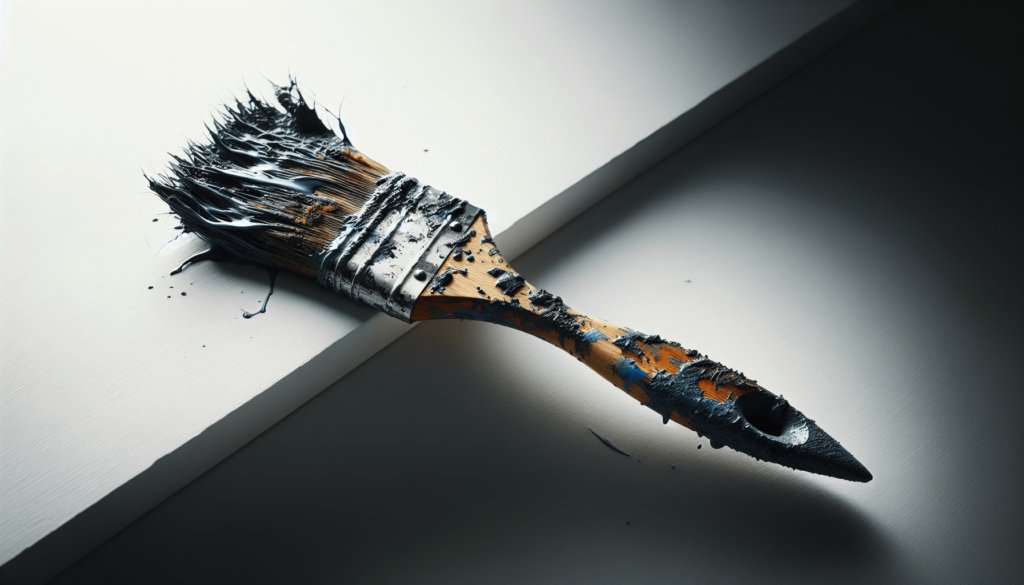
Soaking the Brushes
Using warm soapy water
One of the most common and effective methods of removing dried paint from brushes is by soaking them in warm soapy water. Fill a container with warm water and add a few drops of dish soap. Swirl the brushes around in the soapy water, making sure the bristles are fully submerged. Allow the brushes to soak for at least 30 minutes. After soaking, use a brush comb or your fingers to gently remove any loosened paint. Rinse the brushes thoroughly with clean water and allow them to air dry.
Using vinegar
Vinegar is another excellent option for soaking and removing dried paint from brushes. Fill a container with white vinegar, enough to fully submerge the bristles of the brushes. Let the brushes soak in the vinegar for several hours or overnight. The vinegar will soften the paint and make it easier to remove. After soaking, rinse the brushes with water and gently rub the bristles to remove any remaining paint. Rinse again and allow the brushes to dry.
Using fabric softener
Fabric softener is not only useful for softening clothes but can also help in loosening dried paint from brushes. Fill a container with warm water and add a small amount of fabric softener. Submerge the brushes in the solution and let them soak for several hours or overnight. The fabric softener will break down the paint, making it easier to clean. After soaking, rinse the brushes with clean water and gently remove any remaining paint. Rinse again and allow the brushes to dry thoroughly.
Using paint thinner or mineral spirits
In cases where the paint has dried firmly on the brushes, paint thinner or mineral spirits can be used as a solvent to dissolve the paint. Pour a small amount of paint thinner or mineral spirits into a container. Dip the brush bristles into the solvent and swirl them around, ensuring that the paint thinner reaches all parts of the bristles. Let the brushes soak for a few minutes to allow the paint to loosen. Use a brush comb or your fingers to gently remove the paint. Rinse the brushes with clean water and dry them thoroughly before using them again.
Scraping and Brushing
Using a wire brush or comb
If the dried paint on your brushes is particularly stubborn, you may need to resort to scraping and brushing. A wire brush or comb can be used to scrape off any dried paint particles that are firmly stuck on the bristles. Gently rub the wire brush or comb over the bristles, using short strokes and being careful not to damage the bristles. This method is best suited for removing larger clumps of dried paint. Once the majority of the paint is removed, proceed with the soaking methods mentioned earlier to fully clean the brushes.
Using a toothbrush or nail brush
For smaller brushes or brushes with fine bristles, a toothbrush or nail brush can be an effective tool for scraping and brushing off dried paint. Wet the brush bristles with water and apply a small amount of dish soap or paint thinner to the bristles. Scrub the bristles using the toothbrush or nail brush, focusing on the areas with dried paint. Gently work the bristles to loosen and remove the paint. Rinse the brushes thoroughly with clean water and allow them to dry.
Using a paint scraper or putty knife
A paint scraper or putty knife can be used to remove dried paint from brushes, especially if the paint has hardened. Hold the brush firmly and use the edge of the scraper or knife to scrape off the paint from the bristles. Be cautious not to apply excessive pressure or use a sharp blade that could damage the bristles. Once the majority of the paint is removed, proceed with cleaning the brushes using the soaking or scraping methods mentioned earlier.
Using a stiff bristle brush or scrub brush
In cases of stubborn dried paint, a stiff bristle brush or scrub brush can be effective in breaking down the paint and removing it from the bristles. Wet the brush bristles and apply a small amount of dish soap or paint thinner. Scrub the bristles vigorously using the stiff bristle brush, focusing on the areas with dried paint. Continue scrubbing until the paint starts to loosen. Rinse the brushes thoroughly with water to remove any paint residue, and allow them to dry completely before using them again.
Using Solvents
Using denatured alcohol
Denatured alcohol is a potent solvent that can effectively dissolve dried paint from brushes. Pour a small amount of denatured alcohol into a container and dip the brush bristles into the liquid. Swirl the brushes around in the alcohol, ensuring that the solvent reaches all parts of the bristles. Let the brushes soak for a few minutes to allow the paint to dissolve. Use a brush comb or your fingers to gently remove any loosened paint. Rinse the brushes with clean water and dry them thoroughly.
Using acetone
Acetone is commonly used as a paint thinner and can also be used to remove dried paint from brushes. Pour a small amount of acetone into a container and dip the brush bristles into the liquid. Allow the brushes to soak for a few minutes, making sure the acetone covers the dried paint. Gently rub the bristles with your fingers or use a brush comb to remove the softened paint. Rinse the brushes with water and ensure all the acetone is removed. Allow the brushes to air dry completely.
Using methylated spirits
Similar to other solvents, methylated spirits can be used to dissolve and remove dried paint from brushes. Pour a small amount of methylated spirits into a container and submerge the bristles of the brushes in the liquid. Let the brushes soak for a few minutes, ensuring that the spirits thoroughly penetrate the dried paint. Use a brush comb or your fingers to gently remove the loosened paint. Rinse the brushes with clean water and dry them thoroughly before using them again.
Using turpentine
Turpentine is a traditional solvent often used for cleaning brushes and thinning paint. Dip the brush bristles into a container filled with turpentine, making sure the dried paint is fully submerged. Allow the brushes to soak for a few minutes to soften the paint. Gently rub the bristles or use a brush comb to remove the loosened paint. Rinse the brushes with clean water and dry them thoroughly. Take caution when using turpentine, as it has a strong odor and should be used in a well-ventilated area.
Heating and Soaking
Heating the paintbrush bristles
Applying heat to dried paint can help soften it and make it easier to remove. Hold the bristles of the paintbrush over a heat source, such as a flame or stove burner, for a few seconds. Be cautious not to expose the bristles to the heat for too long, as it can damage or melt them. After heating, proceed with one of the soaking methods mentioned earlier to further clean the brushes.
Soaking the brushes in hot vinegar or ammonia
For dried paint that is particularly stubborn, soaking the brushes in hot vinegar or ammonia can help break it down. Heat a small amount of vinegar or ammonia in a pot or microwave-safe container. Submerge the brush bristles in the hot liquid and let them soak for several hours or overnight. The heat and the acidity of the vinegar or ammonia will help dissolve the dried paint. After soaking, rinse the brushes thoroughly with clean water and dry them completely.
Using a heat gun or blow dryer
Another method for softening dried paint on brushes is using a heat gun or blow dryer. Hold the heat gun or blow dryer several inches away from the paintbrush bristles and apply heat. Move the heat source in a sweeping motion to evenly distribute the heat. The heat will soften the dried paint, making it easier to remove. Utilize one of the previously mentioned cleaning methods to complete the process and remove any remaining paint.
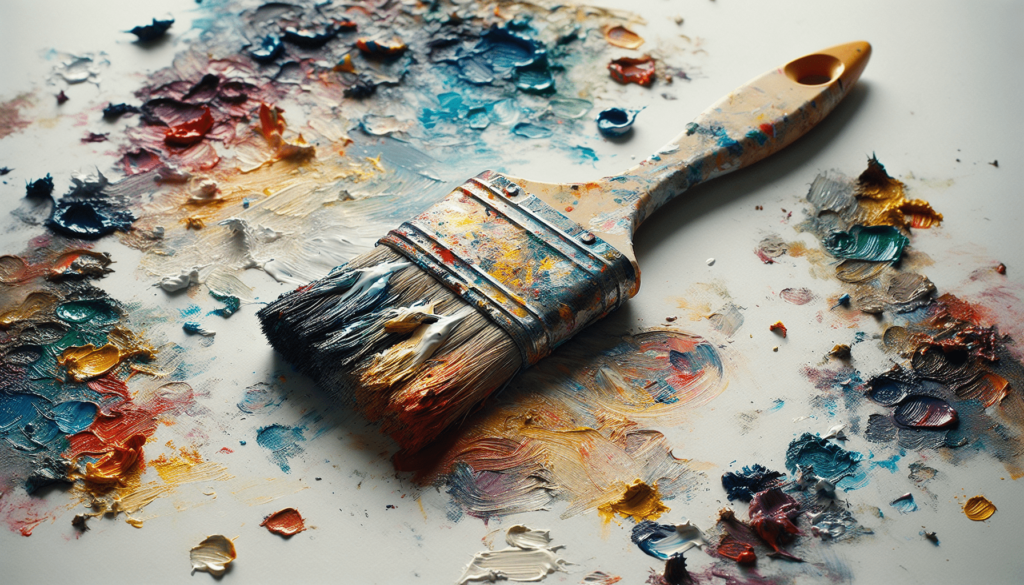
Natural Remedies
Using boiling water
Boiling water can be an effective natural remedy for removing dried paint from brushes. Boil a pot of water and carefully submerge the brush bristles in the boiling water for a few minutes. The hot water will soften the dried paint, allowing it to be easily removed. After boiling, use a brush comb or your fingers to gently scrape off the loosened paint. Rinse the brushes with clean water and allow them to air dry completely.
Using baking soda and hydrogen peroxide
A mixture of baking soda and hydrogen peroxide can create an effective cleaning solution for removing dried paint from brushes. In a bowl, combine equal parts baking soda and hydrogen peroxide to form a paste. Apply the paste to the bristles of the brush, ensuring that the dried paint is fully covered. Let the paste sit on the brush for a few minutes to penetrate and loosen the paint. Gently scrub the bristles with a brush comb or your fingers until the paint starts to come off. Rinse the brushes thoroughly with clean water and allow them to dry completely.
Using lemon juice and salt
Lemon juice and salt can be combined to create a natural cleaning solution for removing dried paint from brushes. In a bowl, mix equal parts lemon juice and salt to form a paste. Apply the paste to the bristles of the brush, ensuring all the dried paint is covered. Let the paste sit on the brush for a few minutes to allow the lemon juice and salt to break down the paint. Gently scrub the bristles with a brush comb or your fingers until the paint starts to dissolve. Rinse the brushes with clean water and dry them thoroughly.
Using vinegar and baking soda paste
Vinegar and baking soda can be combined to create a powerful cleaning paste for removing dried paint from brushes. In a bowl, mix equal parts vinegar and baking soda to form a paste. Apply the paste to the bristles of the brush, making sure to cover all areas with dried paint. Let the paste sit on the brush for a few minutes to allow it to work on the paint. Use a brush comb or your fingers to gently remove the paint. Rinse the brushes with clean water and dry them completely before using them again.
Brush Conditioning
Using a fabric softener rinse
Once the dried paint has been removed from your brushes, it is crucial to condition them to maintain their quality. After cleaning the brushes using one of the methods mentioned earlier, you can give them a fabric softener rinse. Dilute fabric softener with water in a container and dip the cleaned brush bristles into the mixture. Gently swirl the brushes in the fabric softener solution, making sure the conditioner fully coats the bristles. This will help keep the bristles soft and prevent them from becoming stiff after drying. Rinse the brushes with clean water and allow them to dry completely.
Using hair conditioner
Similar to fabric softener, hair conditioner can serve as a great conditioning agent for your paint brushes. Apply a small amount of hair conditioner directly to the cleaned brush bristles. Gently massage the conditioner into the bristles, ensuring all areas are covered. Leave the conditioner on the brushes for a few minutes to allow it to penetrate the bristles. Rinse the brushes thoroughly with clean water and dry them completely. The hair conditioner will help keep the bristles soft and prevent them from becoming stiff.
Using olive oil or vegetable oil
Olive oil or vegetable oil can also be used to condition paint brushes after cleaning. Apply a small amount of oil to a cloth or paper towel and gently rub it onto the cleaned brush bristles. Make sure to cover all areas of the bristles with the oil. This will help keep the bristles moisturized and prevent them from drying out. After applying the oil, rinse the brushes with clean water and allow them to air dry completely.
Mechanical Brush Cleaners
Using a brush spinner or cleaner
For those who frequently use paint brushes, investing in a brush spinner or cleaner can be a time-saving and efficient method for cleaning. A brush spinner is a device that rotates the brush bristles at high speeds, removing excess paint and cleaning them thoroughly. To use a brush spinner, attach the brush to the spinner and turn it on. Allow the spinner to rotate the brush for a few minutes, ensuring that all paint is removed. Rinse the brushes with clean water and dry them completely.
Using a paint brush comb
A paint brush comb is a handy tool for removing excess paint from the bristles and cleaning the brushes after use. After painting, use a paint brush comb to gently scrape off any excess paint from the bristles. This will help prevent the paint from drying and becoming difficult to remove later. Once the excess paint is removed, proceed with one of the cleaning methods mentioned earlier to fully clean the brushes.
Professional Cleaning
Taking the brushes to a professional cleaner
In some cases, when the dried paint is particularly stubborn or the brushes are valuable and delicate, it may be best to take them to a professional cleaner. Professional cleaners have specialized equipment and expertise to remove dried paint from brushes effectively. They can assess the condition of the brushes and use appropriate methods to restore them to their original state. Be sure to inquire about the cost and turnaround time for professional cleaning services.
Using a brush cleaning machine
Some professional painters use brush cleaning machines to efficiently clean their paint brushes. These machines have rotating bristles and use solvents and detergents to remove dried paint from the brushes. If you frequently use paint brushes or have a large quantity of brushes to clean, investing in a brush cleaning machine can be a worthwhile option. Follow the manufacturer’s instructions for operating the machine and cleaning the brushes effectively.
Preventive Measures
Rinsing the brushes thoroughly after use
To prevent dried paint from sticking to your brushes, it is essential to rinse them thoroughly immediately after use. Rinse the brushes under running water, gently working the bristles to remove any remaining paint. Continue rinsing until the water runs clear and all paint is removed. Taking this simple step will make the subsequent cleaning process much easier and help prolong the lifespan of your brushes.
Using brush storage containers or wraps
When your paint brushes are not in use, it is crucial to store them properly to protect their bristles and prevent them from drying out. Use brush storage containers or wraps designed specifically for paint brushes. These containers or wraps will help retain moisture and protect the bristles from getting bent or damaged. Proper storage will also prevent dust and debris from settling onto the brushes, keeping them clean and ready for your next painting project.
Keeping brushes moisturized during breaks
During breaks in painting sessions, it is important to keep your brushes moisturized to prevent the paint from drying on them. Place the brushes in a container filled with water, making sure that the bristles are fully submerged. This will prevent the paint from drying out before you resume painting. Remember to empty the water and rinse the brushes thoroughly before starting to paint again.
Covering brushes with plastic wrap or aluminum foil
When taking short breaks during painting sessions, covering your brushes with plastic wrap or aluminum foil can help prevent the paint from drying out. Wrap the brushes tightly with plastic wrap or aluminum foil to create a barrier and seal in moisture. This will keep the paint wet and prevent it from drying on the bristles. Uncover the brushes and rinse them thoroughly before continuing with your painting.
Conclusion
In conclusion, there are numerous methods available for removing dried paint from paint brushes. Soaking the brushes in warm soapy water, vinegar, fabric softener, or solvents such as paint thinner or mineral spirits can effectively loosen and remove dried paint. Scraping and brushing techniques using wire brushes, toothbrushes, paint scrapers, or stiff bristle brushes can help remove stubborn paint particles. Heating and soaking the brushes in hot liquids or using heat guns can aid in softening the paint. Natural remedies like boiling water, baking soda and hydrogen peroxide paste, lemon juice and salt, or vinegar and baking soda paste can also be used.
After the paint has been removed, conditioning the brushes using fabric softener rinse, hair conditioner, or oils such as olive oil or vegetable oil will help keep them in good condition. Mechanical brush cleaners like brush spinners or paint brush combs can be beneficial for quick and efficient cleaning. For valuable or delicate brushes, professional cleaning or using brush cleaning machines may be necessary. Additionally, practicing preventive measures such as thoroughly rinsing brushes after use, proper storage, maintaining moisture during breaks, and covering brushes during short pauses will prolong their lifespan and prevent paint from drying on them.
By following these comprehensive methods and tips, you can effectively remove dried paint from your paint brushes and maintain them in optimal condition for your future painting projects.
